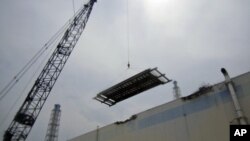Japanese government agencies and the owner of a crippled nuclear power plant say the crisis is being brought under control. Some in Japan are less certain, however, in part because details remain vague about what has been accomplished and the next steps.
Japanese authorities say the second phase of their plan to bring the Fukushima nuclear power plant under control has begun. Goshi Hosono is the special state minister in charge of the four-month-old crisis.
"I assure you that although the progress has been sometimes slow, we are now on the right track toward restoring the situation from the accident," said Hosono.
Questioning progress
But the environmental group Greenpeace has doubts. It says the utility and the government have failed to meet several objectives.
The group says formal deadlines have been rushed. It also maintains that while authorities say the situation with the crippled reactors is stable, in reality it could be decades before the crisis ends.
At a news conference in Tokyo on Wednesday, reporters repeatedly asked why no cumulative figures on radiation emissions from the crippled plant has been released.
Quantifying radiation levels
An official with the Nuclear and Industrial Safety Agency said another government entity now responsible for such reports probably is finding it difficult to "back calculate" the total radiation released because the density levels in the surrounding area in the last few months are so much lower.
Officials say radiation emissions from the plant are one-two millionth of the peak shortly after an earthquake and tsunami battered the nuclear plant on March 11. But Tokyo Electric executive vice president Zengo Aizawa acknowledged a lack of accurate cumulative data.
Aizawa said the damage at the nuclear plant made precise monitoring difficult, but now that the rubble is being cleared away, accurate measurements again can be made, and the data will be compiled and released on a regular, but yet undetermined, basis.
Three of the six reactors at the plant melted down after the disaster. Explosions damaged the building housing at a fourth.
Cold shutdowns, contaminated beef
Authorities expect to begin cold shutdowns of the crippled reactors in about six months. Critics say the government and the utility, though, use a more liberal definition of a cold shutdown compared with the general consensus of the nuclear industry and the scientific community.
High radiation levels forced the evacuation of tens of thousands of households. Crops, milk, seafood and fish near the Fukushima plant were contaminated by fallout. Beef from more than 1,000 cows, which ate feed contaminated with radioactive cesium, was shipped across the country. Some of the meat ended up being sold at supermarkets, served to children at nursery schools and to passengers on Japan's bullet trains.
Energy conservation
The Fukushima disaster and recent shutdowns of other nuclear plants prompted energy conservation measures in the eastern part of the country, including the capital, Tokyo.
Concern has now spread to Osaka, Japan's second largest metropolitan area. The government on Wednesday announced that because of problems with another nuclear reactor and a coal-fired power plant, customers there will be asked to curtail electrical use by more than 10 percent through late September.
A central bank top official has warned of possible economic damage, saying that power shortage casts a shadow on Japan's long-term growth prospects.











